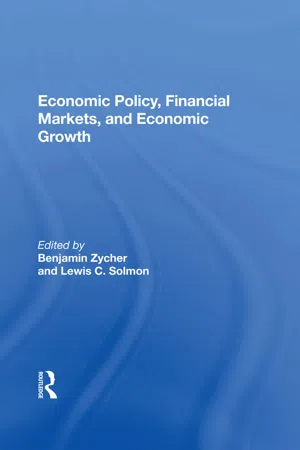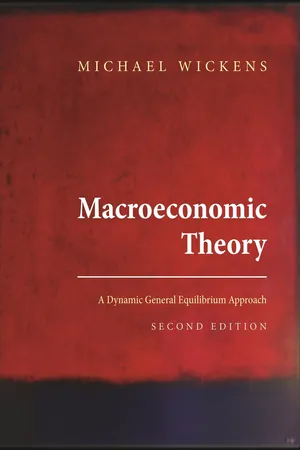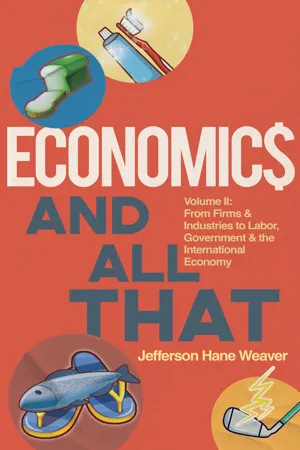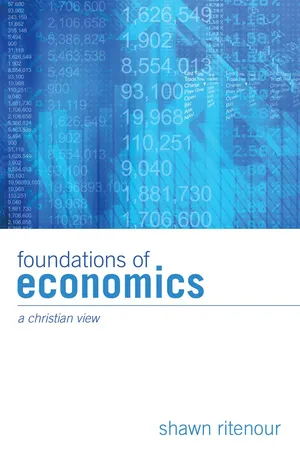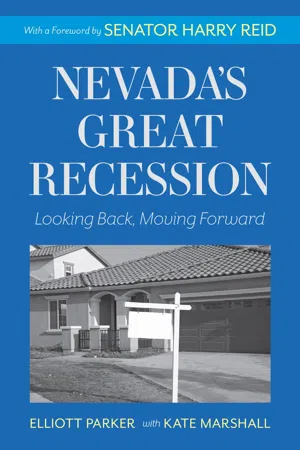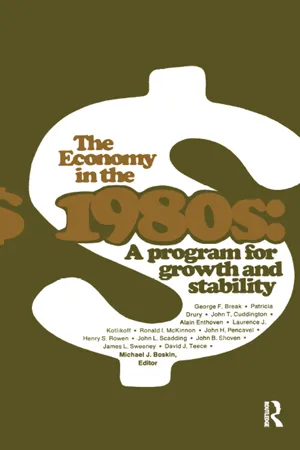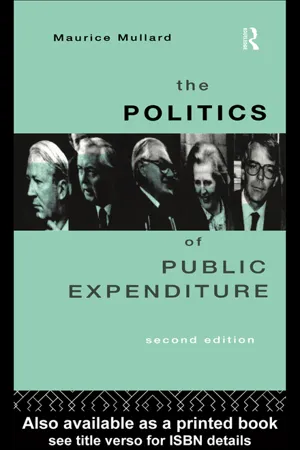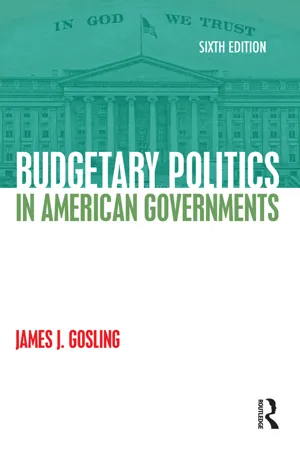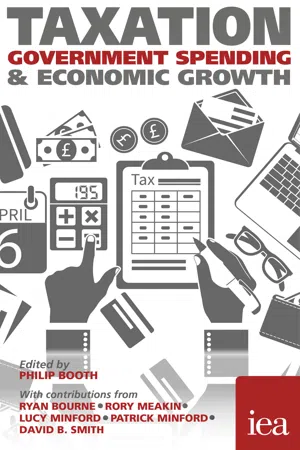Economics
Government Spending
Government spending refers to the total amount of money that a government spends on goods, services, and investments. It encompasses expenditures on areas such as healthcare, education, defense, infrastructure, and social welfare programs. Government spending plays a crucial role in influencing economic growth, employment, and overall well-being of a country's citizens.
Written by Perlego with AI-assistance
Related key terms
12 Key excerpts on "Government Spending"
- Benjamin Zycher(Author)
- 2019(Publication Date)
- Routledge(Publisher)
Government Spending and TaxationPassage contains an image
Introduction
The consumption and reallocation of resources perhaps constitute the very essence of government, achieved in the main through its powers of taxation and spending. That such fiscal activity by the public sector yields both benefits and costs is beyond doubt, but the measurement of those effects remains difficult, despite much research effort over many years. This difficulty does not reduce the need for qualitative and quantitative analysis of the benefits and costs of fiscal activity, as government consumes and redirects a substantial proportion of national output in most of the world.But for market economies, in which prices are assumed to reflect the value and cost of resources, the value of government output in national accounts generally is measured as (or is assumed to be equal to) the cost of the inputs used by government; those costs usually do not reflect secondary but important effects of taxation and spending. If government is “too big”-that is, if aggregate wealth would be increased were some resources shifted away from government back to the private sector-then the national accounts are likely to overstate the value of Government Spending. And the secondary effects of fiscal activity imply that the government budget would understate the true economic cost of taxation and spending.Notwithstanding the existence of a vast literature on the demand and cost of public services, much work remains to be done in terms of both conceptual and empirical analysis of public sector spending and taxation, and attendant effects upon aggregate economic well-being. William A. Niskanen reports empirical findings on the effect of several types of fiscal activities upon three alternative measures of economic growth. He finds that Government Spending increases real GNP significantly, whereas taxes and deficit spending (i.e., future taxation) have significant negative effects. Interestingly, Niskanen finds that the economic benefits of nondefense spending not used for transfer payments-loosely, public sector nondefense investment-may be greater than the economic costs of the taxes and debt needed to finance the additional spending, at least as the benefits are measured in his econometric analysis. One possible problem with this finding is that some or much government investment could be undertaken by the private sector, and it is at least plausible that costs would fall. If that is true, it may suggest that the actual net effect of some Government Spending upon growth and productivity is negative, but not captured by the data.- eBook - ePub
Macroeconomic Theory
A Dynamic General Equilibrium Approach - Second Edition
- Michael Wickens(Author)
- 2012(Publication Date)
- Princeton University Press(Publisher)
Many states also provide goods and services that are not pure public goods. For these government-supplied goods one person’s consumption may well be at the cost of less consumption of these (or of other goods) by someone else. Examples are government-provided education, health, and some forms of transport. These goods and services are often provided by the state on the grounds of equity or efficiency due to economies of scale. Frequently, their public provision is a source of political controversy. Apart from government expenditures on goods and services, there are also government transfers arising from social security benefits, such as unemployment compensation, family benefits, and state pensions.Most people take it for granted that government expenditures form a substantial proportion of GDP, yet this is a relatively recent phenomenon, as can be seen from figure 5.1 , which plots government expenditures as a proportion of GDP for the United States and for the United Kingdom since 1901. Real government expenditures on goods and services and real social security benefits as a proportion of GDP have increased considerably over the last century. In 1901 they were only 2.3% of GDP for the United States and 13.5% for the United Kingdom. In most Western countries they increased from around 10–20% of GDP prior to World War I to around 40–50% after World War II. The wars themselves were the times of the greatest expansion in government expenditures. Since World War II, the shares of government expenditures in GDP have risen steadily and, apart from unemployment benefits, which vary countercyclically over the business cycle, they are not much affected by the business cycle. On average, the expenditures on goods and services and on transfers are roughly equal in size. Total government expenditures also include interest payments on government debt.Government revenues are primarily tax revenues: direct taxes on incomes and expenditure, social security taxes, and corporate taxes. The balance varies somewhat between countries, but for most developed countries direct taxes and social security taxes—which are in effect taxes on incomes—are about 60% of total tax revenue, consumption taxes are about 25%, and corporate taxes are about 10%. The average tax rate on incomes (including social security) is around 42%. Tax revenues tend to be more affected by the business cycle than expenditures. This is the main reason why government deficits tend to increase during a recession. - eBook - ePub
Economics and All That
From Firms and Industries to Labor, Government and the International Economy
- Jefferson Hane Weaver(Author)
- 2023(Publication Date)
- Armin Lear Press(Publisher)
Part Four: The Government and the EconomyGovernment SpendingIn the modern era, the government has become a pervasive—indeed, dominant—presence in our economy. This news will gladden the hearts of those poor misguided souls who still cling to the fantasy that a centrally planned economy is the most efficient and equitable form of economic organization. But even the most rabid free marketer would have to concede—albeit reluctantly—that the government has over time expanded its reach into almost every sector of the economy. Nothing illustrates its preponderance as the proverbial 800-pound gorilla more succinctly than the fact that the government is responsible for nearly one-third of the budgetary expenditures of even the most market-driven nations such as Germany and theUnited States.There are certain areas in which the government is inextricably bound to private sector actors. Not surprisingly, its traditional obligation to provide for a common defense ensures that it has a very close relationship with defenses contractors—many of whom are dependent on government contracts for their very existence. The government also provides enormous funding for education as well as numerous research and development projects with various colleges and universities. However, the single largest role played by the government nowadays involves the administration of the gargantuan health and welfare programs that consume the biggest share of the federal budgeteach year.Modern governments have grappled with the unfortunate reality that their citizens have an infinite appetite for government services (known by the technical term as “free stuff”) but comparatively little willingness to pay for those services in the form of higher taxes. However, policy makers have also discovered over time that nobody really cares very much about such virtuous actions as balancing the budget (which is really a quaint notion that has quietly passed into history without so much as a whimper), let alone beginning to pay down the national debt. After all, a reduction in government expenditures might have a contractionary effect on the economy, which would in turn negatively impact the gross domestic product (GDP) of the nation and, quite possibly, the electoral prospects and financial fortunes of our leading politicians. Because Government Spending has become such an integral feature of the economy, with entire industries such as national defense and healthcare vitally dependent on the continued flow of government funds, there is a natural bias across the political spectrum in favor of the continuous expansion of government programs—whether they pay for military bases or highways or bridges or any of an almost infinite variety of other projects. So it is not the case that Government Spending is inherently bad. After all, it would be very difficult to imagine a privately funded national postal service that served every resident of the country or a military paid for by private donations that could project its power to almost every region of the world. Even the most vocal critics of Government Spending acknowledge that a national government is necessary for certain basic functions. What many of them criticize, however, is the fact that the government has become more entangled in the private sector and has asserted greater regulatory power over areas that were formerly left to private actors to manage. They also argue that the government is typically less efficient than private sector actors who are compelled to minimize their costs and consumption of resources to compete effectively against other businesses. This argument, while attractive on its face, ignores the fact that both private businesses and government agencies are run by fallible people. As a result, one cannot say that a private firm will invariably perform a certain function with greater competency and efficiency than a public agency. However, the private firm will typically have a greater incentive to watch its pennies because it cannot count on its monies being doled out to it by a benevolent legislature that is quite comfortable with bloated social - eBook - ePub
- (Author)
- 2023(Publication Date)
- Wiley(Publisher)
B is correct. Government borrowing may compete with private sector borrowing for investment purposes.4. Fiscal Policy Tools
We now look at the nature of the fiscal tools available to a government. Government spending can take a variety of forms:Learning Outcome
The candidate should be able to:- ☐ describe tools of fiscal policy, including their advantages and disadvantages
-
Transfer payments are welfare payments made through the social security system and, depending on the country, include payments for state pensions, housing benefits, tax credits and income support for poorer families, child benefits, unemployment benefits, and job search allowances. Transfer payments exist to provide a basic minimum level of income for low-income households, and they also provide a means by which a government can change the overall income distribution in a society. Note that these payments are not included in the definition of GDP because they do not reflect a reward to a factor of production for economic activity. Also, they are not considered to be part of general government spending on goods and services.
-
Current Government Spending involves spending on goods and services that are provided on a regular, recurring basis—including health, education, and defense. Clearly, such spending will have a big impact on a country’s skill level and overall labor productivity.
-
Capital expenditure
- eBook - ePub
Foundations of Economics
A Christian View
- Ritenour(Author)
- 2010(Publication Date)
- Wipf and Stock(Publisher)
16Taxing and Spending
I n the previous two chapters we discussed the nature and consequences of two forms of government intervention in the market. The first was inflation and the second was price controls. The state, however, also has a great impact on the market through its budget. Government taxing and spending have serious economic consequences.Every year the state spends funds on whatever it decides is worthy. There are two primary reasons that the government spends money. One is to benefit particular people or groups of people. The other is because of a belief that Government Spending can help generate and maintain economic prosperity and the public good.In order to do anything, the state needs economic goods. Because the state has a legal monopoly on the use of violence, it could just confiscate the goods it needs from the citizenry. However this method of acquisition is extremely unpopular and increases the likelihood of rebellion; it is also somewhat inefficient because the state would have to know who had what goods and some of the goods that it wants (such as tanks and anti-aircraft artillery) may be very hard to locate.Therefore, the state finds it advantageous to operate within the monetary economy. To function in the monetary economy, government needs money. The state must have access to funds that it can spend trying to achieve whatever ends it has. If the government wants to enforce price controls, if it wants to provide military defense or police services, if it wants to support artists or scholars by subsidies, or if it gives out educational welfare in the form of Pell grants and subsidized student loans, if the state wants to accomplish anything, it must spend money.In order to spend money, the government must first obtain revenue. The path that the state takes to receive revenue is intervention in the free market, obtaining funds through coercion. There are three sources of revenue available to the government: inflation, taxation, and borrowing. - eBook - ePub
Nevada's Great Recession
Looking Back, Moving Forward
- Elliott Parker, Kate Marshall(Authors)
- 2017(Publication Date)
- University of Nevada Press(Publisher)
Most economists think of the relationship between the size of government and the growth of the economy as an inverted-U. At the extremes, you have Somalia or Haiti without a functional public sector, and the now-deceased Soviet Union that had no functioning private sector. Economic development is most successful somewhere in between. Compared to those of other developed countries, our government is relatively small. While the political left and right squabble over whether the optimal level is more or less than our current amount, others try to look at what the statistical evidence tells us.When looking at the overall level of Government Spending, macroeconomists once thought the effect was clearly positive. They theorized that when government spent more, those who provided these goods and services made more money, and they in turn would spend more on goods and services provided by others. Tax cuts provided a similar, if smaller, effect.Economists today are now more skeptical. Many claim that Government Spending often crowds out private spending, especially when unemployment rates are low and markets are functioning reasonably well. If government gets its spending money from taxpayers, then private households have less for their own consumption, and so the public goods need to be worth it. If government still spends while cutting taxes, then it has to cover the deficit by borrowing from capital markets, leaving less for the private sector. This increases real interest rates and reduces private investment.If the deficit is instead financed with lending from the central bank, new money is created, resulting in inflation if the money supply grows faster than the money demanded by the needs of the real economy. If the deficit is financed by borrowing from abroad, then exports fall instead, since every dollar a foreigner lends us is a dollar that he or she does not spend on our goods. That borrowing is why we have a huge trade deficit, and it won’t turn around until we start paying back what we owe.Good policy, then, means taxing ourselves enough to pay for the public goods that we think benefit us. In the long run, the overall deficit should be no more than enough to finance a small increase in money supply that just meets the demands of a growing economy. - eBook - ePub
- Rob Dransfield(Author)
- 2013(Publication Date)
- Routledge(Publisher)
Quantitative easing – involves the government creating credit in the economy by printing more money. This creates additional demand in the economy at a time when consumers and the government are cutting back their expenditures. In contrast, those who support classical/neoclassical and monetarist ideas see the ideal budget as being a balanced budget.The difference between Government Spending and taxes is referred to as the public sector borrowing requirement (PSBR). When there is a fiscal deficit (taxes are less than Government Spending) the government will need to borrow by selling long-term government bonds or short-term bills.Key TermKey TermGovernment bonds – long-term securities that pay a fixed rate of return. They have a long period (e.g. ten years or longer) before they mature (i.e. when they are repaid to the lender). Government bonds are usually bought by financial institutions seeking a safe source of investment.Treasury bills – the government regularly issues (sells) treasury bills. These are sold on the money market. They are usually sold for a period of 90 days, and are bought by discount houses. Discount houses buy the treasury bills for less than their face value (i.e. at a discount).Local government expenditures involve payments that the council disburses for running local services – for example, to contracting companies to collect local refuse or to maintain local parks, as well as maintaining local roads and providing street lighting. The council then pays for these services through two main sources: council tax (paid by householders) and a grant from central government. Where local council expenditures are greater than revenues, the local council will need to borrow by issuing local government bonds.Key TermPublic sector net cash requirement (PSCNR) – this is the total borrowing by national and local government.Key ThemeReasons for public spendingThe key reasons why the government spends money in the economy are set out below:- To supply goods and services that the private sector would not provide in the normal course of events. Examples include the police and fire service, hospitals and state schools, as well as welfare payments and benefits such as unemployment pay.
- eBook - ePub
The Economy in the 1980s
A Program for Growth Stability
- Michael J. Boskin(Author)
- 2019(Publication Date)
- Routledge(Publisher)
6 Since the impact on private incentives of the overall budget is obviously much greater than that of any individual program, in evaluating the desirability of specific programs it is impossible to estimate the opportunity costs of diverting funds from the private sector to the government without knowing the total size of the budget. We would expect that the larger the spending package, tax rates would increase and hence the greater would be the disincentives to the private economy to work, save, invest, and innovate.This is one extremely important type of overall budget policy concern. Another—and one that frequently dominates short-run spending and tax decisions—concerns the likely effect of the budget on economic stability. That is, budget policy often is devoted to attempted countercyclical fiscal activity at the expense of explicit cost-effective and target-effective spending evaluation.Many economists used to believe that increases in Government Spending on purchases of goods and services, when financed by deficits, could substantially increase GNP. Operating in the familiar “multiplier” fashion of Keynesian economics, the increased Government Spending would increase GNP by a multiple of the original spending increase. In such a climate, when it was presumed that the economy was well below full employment, spending programs were presumed to generate extra income and hence little pressure was felt for careful cost-benefit analyses.Economists now question the extent to which changes in Government Spending can influence GNP, how rapidly they can do so, and whether the attempt to “fine tune” the economy by variations in spending levels makes much sense. Some of the reasons are lags in the economy and the implementation of budget policy, difficulties in forecasting, and longer-term considerations concerning the ultimate need to pay future taxes to finance the interest payments on any debt issue (see Chapters 4 and 7 ).Considering also that federal spending on transfer payments now exceeds spending on goods and services, it is highly misleading to think that the budget deficit can be a measure of the stimulative or contractionary effect of the government’s operations on the economy. The issue is further clouded by an attempt to use a so-called “high employment” or “full employment” estimated budget surplus or deficit-one which adjusts actual or estimated spending and revenues, and hence deficit or surplus, to estimated levels at high or full employment. Unfortunately, economists are far from agreed about the natural unemployment rate. Most of us would now put it at 6.0 percent or more. The administration currently is using 4.9 percent. The Humphrey-Hawkins Act uses 4.0 percent. Yet the sensitivity of both budget revenues and spending to changes in the unemployment rate can be substantial. Disagreements over the full employment level therefore can produce substantial differences in estimations of surpluses or deficits at full employment. Policymakers have often used the high employment estimates to justify increased spending to reach the alleged high employment level.7 - eBook - ePub
- Maurice Mullard(Author)
- 2005(Publication Date)
- Routledge(Publisher)
The second problem in defining public expenditure is related to whether all public expenditure should be treated in a homogeneous manner, and whether all government activities should be assumed to be exhaustive expenditure. This question is directed at the assumption that public expenditure represents a resources reallocation from the private to the public sector with no attempt to evaluate the correctness of such an approach. The author (Mullard 1987) has argued that public expenditure has to be disaggregated into the capital, current and transfer components of the expenditure programme. This is important because it can then be asked whether the transfer component of an expenditure programme should represent a resource reallocation to the public sector. Transfer payments on social security, education grants, subsidies on transport and housing, agriculture and the nationalised industries have the common characteristic of increasing the demand potential of their recipients by either giving the recipient a direct cash benefit or by indirectly reducing the price of a commodity. The effect of transfers, therefore, must be a reallocation of income between different income groups, a process which is carried out by the public sector, rather than being an activity carried out on behalf of the public sector.Changes in Public Expenditure: The Historical ContextThe study of public expenditure utilised in this text continues the process adopted by the author in previous publications (Mullard 1987, 1990). These studies have usually addressed the following concerns:(a) The provision of an analysis of public expenditure as a total whilst seeking to provide a measurement which takes into account the rate of inflation which influences changes within this total. The argument has been that using one deflator like the GDP to account for inflation was not sufficient and therefore what was needed was to apply various deflators. Within this context, therefore, the following expenditure programmes have been selected and then disaggregated by economic category: - eBook - ePub
- James J. Gosling(Author)
- 2015(Publication Date)
- Routledge(Publisher)
Besides determining those who benefit from public spending and those who pay for it, government policy makers decide the size of individualized benefits and how much should be spent on benefits that are less readily divisible. Moreover, within notable constraints, public policy makers also determine how fast Government Spending should grow and which revenue sources should finance that growth.Several factors push up public expenditures: inflation, population growth and its attendant claims on public services, growth in the number of individuals who meet previously enacted benefit entitlements, the creation of new public programs, and the expansion of existing ones, to name a few. Spending pressures associated with inflation manifest themselves in higher prices for supplies, purchased services, and capital goods, as well as higher expectations and demands for salary increases on the part of public employees who want to preserve their purchasing power.Population growth increases demands on basic government and education services. Depending on the nature of that growth, it can also burden social welfare services—particularly when individuals who meet eligibility standards are deemed to have the right to collect approved benefits irrespective of the amounts appropriated to finance them. Finally, the enactment of new programs to meet emerging needs obviously brings with it new expenditure claims, as does the expansion of existing programs.As the adage goes, “there is no such thing as a free lunch”; someone has to pay to finance spending increases. Either additional revenues must be raised or expenditure cuts must be made elsewhere, with the freed-up revenues reallocated to finance the areas of growth. The quest for additional revenues again raises the question of who should pay to support increased spending, and the identification of reductions in the base budget raises the issue of whose existing benefits should be reduced. Clearly, however, not all expenditure cuts will necessarily result in a reduction of public benefits; some may merely necessitate increased efficiencies in administration and service provision. But after a point, base cuts can no longer be accommodated by efficiency or productivity improvements; services or other benefits must be reduced. - Philip Booth, Ryan Bourne, Rory Meakin, Lucy Minford, Patrick Minford, David B. Smith(Authors)
- 2016(Publication Date)
- London Publishing Partnership(Publisher)
In addition to Ricardian Equivalence effects, private capital formation also seems to be reduced by budget deficits, because of the uncertainties created with regard to future taxes and interest rates. This suggests that when spending is financed by deficits it will ultimately crowd out roughly the same volume of activity as if it is financed by taxes – though the effects of financing spending via taxes might come through less quickly. Indeed, in this context, it is conceivable that the present sluggish growth observable in so many Western economies reflects the supply-side hangover that followed the Keynesian-inspired public spending binge that was the politicians’ reaction to the financial crash.This analysis suggests that the tax burden ought really to be measured by looking at total Government Spending which is financed by taxes and borrowing (in effect, deferred taxes in most cases). The ratio of general government expenditure to national income is shown in Figure 2 .No institution can tax itselfThe second important truism, which follows from the previous analysis, is that the tax base is not total gross domestic product (GDP) but only the residual component of GDP after Government Spending has been subtracted – in other words, we should focus on the burden of government on the private sector. Individual arms of government pay taxes to other parts of government (e.g. local authorities pay VAT on their purchases). However, these transfers net out for government as a whole, even if this is not always apparent in the published statistics.Regrettably, the longer-term projections for tax receipts made by the Office for Budget Responsibility (OBR) appear to be largely driven by their predictions for money GDP. However, the public/private distinction is highly important when forecasting because the ratio of private to total GDP shows marked cyclical swings (see Figure 2 ). Some of the forecasting errors in the official predictions of government receipts from the OBR – and HM Treasury before them12- Tewodaj Mogues, Samuel Benin, Tewodaj Mogues, Samuel E Benin(Authors)
- 2012(Publication Date)
- Routledge(Publisher)
Government includes central government (government departments, offices, establishments, and other bodies that are agencies or instruments); state, provincial, or regional government; local government; supranational authorities. Expenditures are outlays.Notes1 Since the time when the empirical research of the studies in this volume was conducted, a new dataset on public expenditures has been developed by IFPRI, the Statistics on Public Expenditures for Economic Development, or SPEED. This dataset is publicly available and can be accessed at www.ifpri.org/book-39/ourwork/programs/priorities-public-investment/speed-database and is periodically updated. The dataset is described by Malaiyandi (2010).2 Total expenditures are broken down into the various sectors found in the International Monetary Fund’s Government Finance Statistics
Index pages curate the most relevant extracts from our library of academic textbooks. They’ve been created using an in-house natural language model (NLM), each adding context and meaning to key research topics.
